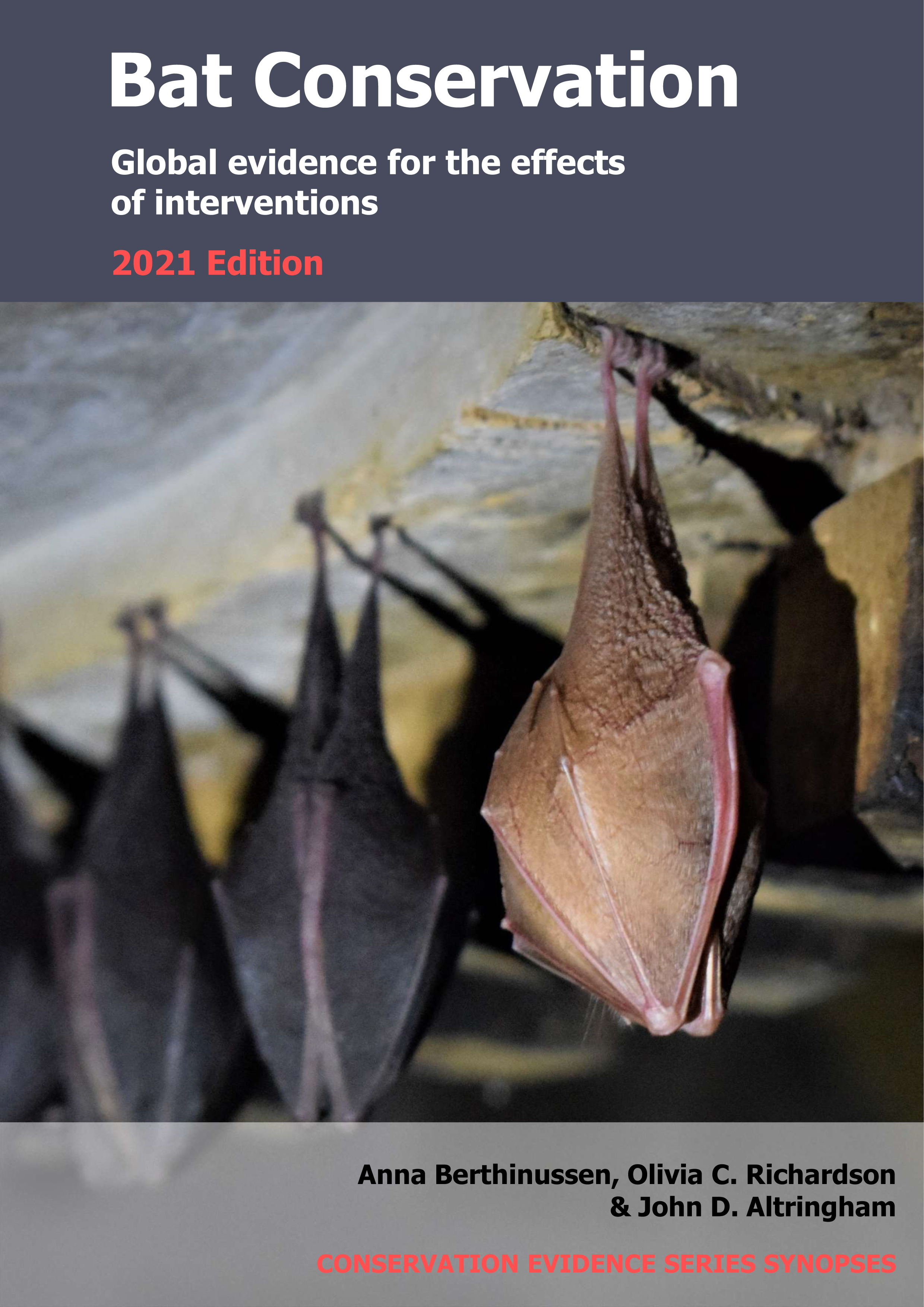Avoid illumination of bat foraging, drinking and swarming sites
-
Overall effectiveness category Likely to be beneficial
-
Number of studies: 2
View assessment score
Hide assessment score
How is the evidence assessed?
-
Effectiveness
80% -
Certainty
52% -
Harms
0%
Study locations
Supporting evidence from individual studies
A replicated, randomized, before-and-after study in 2015 of four cattle troughs within forest in central Italy (Russo et al 2017; same study area as Russo et al 2019) found that unlit troughs had higher drinking activity for five of six bat species/species groups than troughs illuminated with artificial light. More drinking buzzes were recorded for five bat species/species groups when troughs were unlit than when they were illuminated with artificial light: barbastelle bat Barbastella barbastellus (unlit: 584; lit: 306), brown long-eared bat Plecotus auritus (unlit: 78; lit: 0), Myotis spp. (unlit: 599; lit: 134), Kuhl’s pipistrelle Pipistrellus kuhlii (unlit: 116; lit: 64) and Savi’s pipistrelle Hypsugo savii (unlit: 39; lit: 10). For the common pipistrelle Pipistrellus pipistrellus, the difference was not significant when troughs were unlit (240 drinking buzzes) or illuminated (165 drinking buzzes). Each of four cattle troughs consisted of two troughs (6 x 1.5 m) joined together. Troughs were illuminated with a portable LED (light-emitting diode) white light (average 49 lux). Each of four sites was surveyed using bat detectors on two nights with five randomized lit and unlit 10-minute periods/night in July–August 2015.
Study and other actions testedA replicated, before-and-after study in 2015–2016 at six cattle troughs within forest in Italy and three natural desert ponds in Israel (Russo et al 2019) found that unlit troughs within forests had higher drinking activity for six of eight bat species/species groups than troughs illuminated with artificial light, and unlit desert ponds had higher drinking activity for all of three bat species than illuminated ponds. At forest sites, more drinking buzzes (average/30 min interval) were recorded when troughs were unlit than when they were illuminated for barbastelle bat Barbastella barbastellus (unlit: 250; illuminated: 140), Myotis spp. (unlit: 160; illuminated: 40), Natterer’s bat Myotis nattereri (unlit: 35; illuminated: 8), brown long-eared bat Plecotus auritus (unlit: 50; illuminated: 4), common pipistrelle Pipistrellus pipistrellus (unlit: 88; illuminated: 76) and Leisler’s bat Nyctalus leisleri (unlit: 11; illuminated: 4). The difference was not significant for Kuhl’s pipistrelle Pipistrellus kuhlii (unlit: 28; illuminated: 46) or Savi’s pipistrelle Hypsugo savii (unlit: 18; illuminated: 7). At desert sites, more drinking buzzes were recorded when ponds were unlit than when they were illuminated for desert pipistrelle Hypsugo bodenheimeri (unlit: 1,040; illuminated: 260), trident bat Asellia tridens (unlit: 240; illuminated: 70) and Kuhl’s pipistrelle (unlit: 45–1,270; illuminated: 10–350). Troughs (same study area as Russo et al 2017) and ponds were illuminated with a portable LED (light-emitting diode) white light. At each of nine sites, one bat detector recorded bat activity for four hours on two consecutive nights (one unlit, one lit) in July–August 2015 (forest) and July 2016 (desert).
Study and other actions tested
Where has this evidence come from?
List of journals searched by synopsis
All the journals searched for all synopses
This Action forms part of the Action Synopsis:
Bat Conservation
Bat Conservation - Published 2021
Update 2020





)_2023.JPG)














